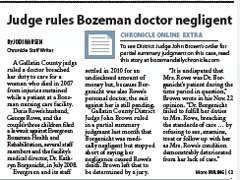Medical Malpractice
The Bozeman, Montana–based firm of Waddell & Magan handles medical malpractice cases not only in Montana but nationwide on a selective basis.
Overview of the medical malpractice crisis
Doctors and hospitals save lives. They put us back together after horrible car wrecks, they treat our ailments, and help deliver new life into the world. They often face the gravest of situations and deserve our respect. But, as in any profession, the errant health care provider should be held responsible for the injuries he or she causes, and by the nature of their jobs, doctors and hospitals are in a position to do real harm. In 2000, medical errors in hospitals were estimated to kill between 44,000 and 98,000 patients each year, according to a report released by the Institute of Medicine in Washington. ("To Err is Human: Building a Safer Health System," Committee on Quality Health Care in America, Institute of Medicine, National Academy Press, Washington, D.C. 2000.)
Examine those numbers again, they are astounding – medical malpractice kills between 44, 000 and 98,000 people a year. This means that more people are killed each year by medical error than were killed during all of the years of the Viet Nam War. According to the Washington Post, however, medical errors may now be the third leading cause of death in the U.S., "claiming 251,000 lives every year".
Despite the reality of the health care provider's position to cause catastrophic injury and death, and despite the incidence of negligence itself, health care providers, the insurance industry, state and federal legislatures, and the courts, have successfully limited a malpractice victim's access to the courts, and to compensation for their injuries. They have done this by systematically hacking away at the statute of limitations (the time an injured person has to bring a lawsuit), requiring that negligence and causation be shown before submitting the issues to a jury, shielding investigations and proof of negligence uncovered by hospital committees, and placing caps (limits) on the amount of money persons injured by medical malpractice can receive even if they surmount all of the obstacles and prove their case.
There are a number of key issues you should know about your potential medical malpractice case, and the minefield you must cross to successfully hold a health care provider liable for acts of medical negligence, and we have tried to answer several of them below. But make no mistake, you will need an attorney well versed in this extremely complex area of the law to guide your case to a successful conclusion.
What is the time limit, or statute of limitations, for filing a medical malpractice claim?
M.C.A.§27-2-205 An action in tort or contract for injury or death against a physician or surgeon, physician assistant, dentist, dental hygienist, registered nurse, advanced practice registered nurse, nursing home or hospital administrator, dispensing optician, optometrist, licensed physical therapist, podiatrist, psychologist, osteopath, chiropractor, clinical laboratory bioanalyst, clinical laboratory technologist, pharmacist, veterinarian, a licensed hospital or long-term care facility, or licensed medical professional corporation, based upon alleged professional negligence or for rendering professional services without consent or for an act, error, or omission, must, except as provided in subsection (2), be commenced within 2 years after the date of injury or within 2 years after the plaintiff discovers or through the use of reasonable diligence should have discovered the injury, whichever occurs last, but in no case may an action be commenced after 5 years from the date of injury.
However, this time limitation is tolled for any period during which there has been a failure to disclose any act, error, or omission upon which an action is based and that is known to the defendant or through the use of reasonable diligence subsequent to the act, error, or omission would have been known to the defendant. (2) Notwithstanding the provisions of M.C.A. §27-2-401, in an action for death or injury of a minor who was under the age of 4 on the date of the minor's injury, the period of limitations in subsection (1) begins to run when the minor reaches the minor's eighth birthday or dies, whichever occurs first, and the time for commencement of the action is tolled during any period during which the minor does not reside with a parent or guardian
Please contact a lawyer as soon as you suspect an injury due to medical malpractice! Too many victims are barred from recovering their rightful compensation every day in our court system because they are not aware of the applicable time limits.
Are my damages limited by damage caps?
Yes. In Montana, medical malpractice cases have a limit of $250,000 on the non–economic damages a victim can recover. M.C.A. §25–9–411. Non–economic damages include physical and mental pain and suffering, emotional distress, loss of companionship or consortium, and injury to reputation or humiliation.
This cap applies only once to an injury even if caused by a series of acts or more than one health care provider. Interestingly, a jury is never instructed about the cap or that any award that exceeds it is reduced by the court.
Additionally, at the request of any party, the court must enter an order for the periodic payment of any future damages that exceed $50,000. M.C.A. §25–9–412 . If the plaintiff dies before all of the payments have been made, then the remaining payments become the property of his or her estate.



